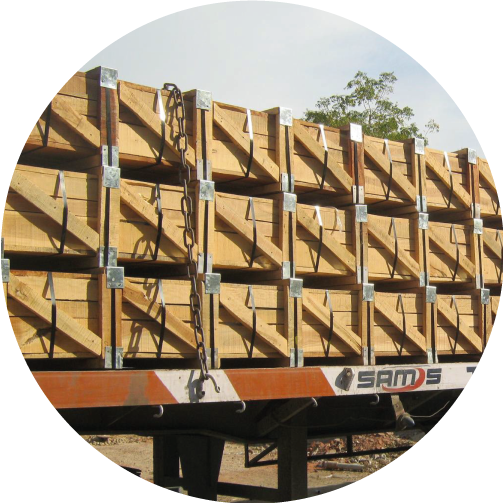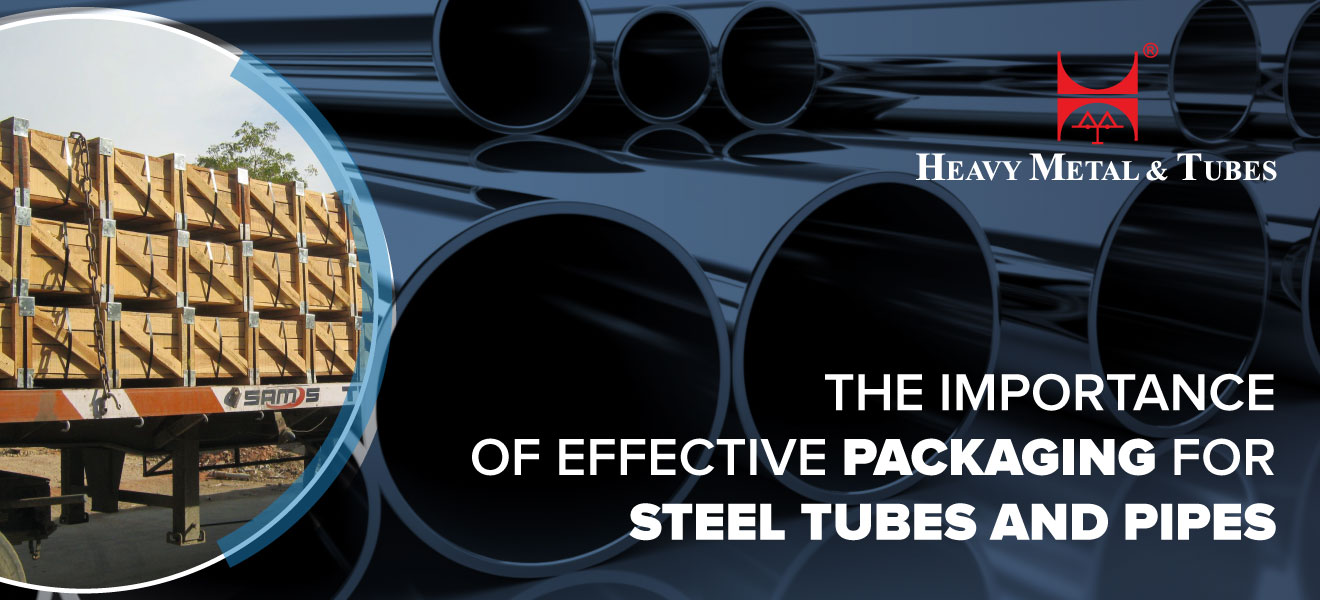The Importance of Packaging for Stainless Steel Tubes and Pipes
At Heavy Metals and Tubes (India) Pvt. Ltd., we understand that delivering high-quality products goes beyond just manufacturing them. Our responsibility continues until our stainless steel tubes and pipes reach you in perfect condition. That’s why we offer strong, reliable, and customized packaging solutions. Each packaging method is carefully selected to protect the pipes during transit and to meet your specific requirements.


Introduction
Stainless steel tubes & pipes are the foundation of machinery, process systems & infrastructure in multiple industries, such as construction, oil & gas, automotive, pharmaceutical & more, in the age of manufacturing & industrial supply chains. These Stainless steel tubes & pipes need to be handled carefully, especially when in transit, regardless of their durability and strength. Packaging is one of the most crucial yet usually failed to notice detail of this process.
Along with it endangering the steel tubes & pipes physical integrity, improper packaging also affects delivery times, client satisfaction, and adherence to international shipping laws. Coherent packaging is a crucial quality assurance strategy that goes beyond simple logistics.
Why Packaging Matters in the Stainless Steel Tube Industry
1. Protecting Product Integrity During Transit
The well built stainless steel tube may sustain surface corrosion, dents or even slight bending if its not properly packed. This damages can make a product unsellable, particularly for polished stainless steel tubes (such as those with a mirror or satin finish). Packaging helps to sock up shock, reduce vibration & avoid steel-to-steel contact, preserving surface quality & geometric integrity.
2. Reducing Returns, Rejections, and Liability
Industry researchers calculates that producers lose millions of dollars every financial year as a result of returns brought on b error in transportation. Many of these problems are caused by avoidable packaging faults rather than manufacturing flaws. Repolishing, reinspection & reshipment come at a hefty price. Reputational harm, project delays & product rejections are all significantly decreased by effective packing.
3. Regulatory and Client Compliance
Large scale buyers and government projects often include stringent packaging requirements in purchase orders. Whether it's labeling for batch traceability, ISPM 15-compliant wooden crates for export, or moisture control for marine shipping, manufacturers must adhere to specifications or face penalties.
Protecting Product Integrity During Transit
Even though stainless steel pipes & tubes are made to be strong, accurate & long lasting, the process of getting them from the producer to the final consumer can be anything but kind. These components are subject to several risks while in transportation, whether they are being transported by road, rail or sea. Even the most carefully made pipes may undergo irreversible damage if not packed properly.
Common Transit Hazards Include:
Mechanical Impact: Dents, scratches or end damage may result from rough handling by cranes or forklifts.
Vibration & Shock: Friction between bundled tubes can caused by micro vibrations from long-distance road transportation.
Moisture Exposure: Changes in humidity, especially during sea freight can lead to erosion even in stainless steel grades which is not designed for marine environments.
Contamination: For polished / sanitary grade pipes: dust, oil & other pollutants can impair both the pipes visual appeal & functionality.
Putting plastic film or PVC sleeves over each tube to prevent metal-to-metal contact.
Using desiccants & Vapor Corrosion Inhibitor paper inside wooden crates to fight moisture and corrosion.
To stop internal contamination & pipe end deformation, use plastic end covers.
Securing the load with anti-slip padding and steel strapping to minimize movement during handling and shipping.
In high-value / export shipments these tubes are frequently placed in sterilized wooden crates or modular steel-reinforced frames which further ensures the load withstands pressure & weather fluctuations.
Ultimately by investing in robust transit packaging, helps manufacturers to avoid hidden costs like returns, reputational damage & customer complaints. It’s a small upfront cost that protects a much larger investment your product’s quality and your brand’s reliability.
View more : Cold Drawn Carbon & Alloy Steel
Standard Packaging Solutions for Steel Tubes and Pipes
1. Hessian / PVC Cloth Bundles with PVC Box Strap or Hexagonal Bundles
These packaging techniques are popular in local markets and short-distance deliveries and this technique are economical & easy to use. They provide simple manual handling or forklift operation & provide mild abrasion protection. They are not advised, therefore, for shipping abroad or in severe weather.
2. Wooden Crate Packaging
One of the most reliable packaging methods, wooden crates provide robust structural support. This Wooden Crates protect pipes from:
- Stacking pressure
- Rough mechanical handling
Manufacturers frequently use treated and certified wooden materials to meet international regulations, especially for exports to the EU, USA, or Japan.
3. Custom Packaging for U-Bend and Thin-Walled Tubes
These tubes are more susceptible to surface scratches and bending. Innovations in packaging include:
- Form-fitting foam or cardboard inserts;
- Shrink wrap over bends to preserve geometry; and
- Layed packing with separate separators.
By taking these measures, the tubes are guaranteed to keep their exact diameter and curvature while in transit.
4. Heavy-Duty Steel Pipe Packaging
Used for oil pipelines and structural tubes, heavy pipes require reinforced packaging:
- Steel banded wooden skids
- Plastic end protectors
- Water resistant wrapping
Some exporters add GPS-tracked seals to high-value pipe packages to deter tampering during cross-border transit.
5. PVC Sleeve Tubes Packed in Wooden Boxes
This technique is idle for attractive & sanitary tube applications since it promises
- Well-organised stacking
- Maximum surface protection
- Moisture barrier
This method fullfills the requirements of sectors such as architectural installations and food processing.
6. Steel Tube Packaging for Domestic Transit
This strategy of packaging is designed for short-distance movement within industrial zones or between cities. It highlights economical materials with a reasonable level of protection against physical harm.
- Typically involves hexagonal bundles or PVC cloth wrapping
- Box strapping ensures compact and secure handling
- Ideal for forklift loading and unloading
Offers limited protection from weather and is not suitable for long hauls or sensitive surfaces
Domestic packaging is designed for quick turnaround & ease of local distribution, prioritizing efficiency over extended durability.
7. Packaging for Stainless Steel Tubes & Pipes in India
Packaging in India is modified to take in various climates & modes of transportation. It integrate practicality & compliance for clients in the industrial &architecture sectors.
- Hessian fabric or LDPE film are frequently used for external wrapping.
- Colour coded straps are oftenly used to identify different grades & sizes
- Wooden supports or skids are oftenly used in high load or rail shipments
- Protective wrapping is increased during monsoon season or coastal delivery
This approach ensures safety throughout India's vast territory by supporting both local deliveries & pre-export interior operations.
8. International Pipe Export Packaging
Export packaging is designed for cross-border, long-distance transportation. It offers the best defence against mechanical and environmental hazards and conforms with international requirements.
- Products are packed in ISPM 15-certified wooden crates or pallets
- Wrapped in VCI paper, plastic film or PVC sleeves
- Steel straps and desiccants are used to manage load security and moisture
- Includes detailed labeling & markings for customs and client identification
International packaging ensures that tubes and pipes arrive in perfect condition, preserving surface quality and meeting client expectations across regions like the European Union, Middle East & North America.
Custom Steel Pipe Packaging Solutions
1. Tailored Packaging Based on Purchase Order
German clients might want multilayer labelling & accurate barcoding, but a Saudi Arabia's buyer might need waterproof crates with Arabic labels. Oftenly manufacturers have to provide:
- Personalised stencil printing featuring heat numbers and box weight indicators
- The packaging has certificates of conformance attached.
2. Options for Special Tube Applications
Some of the applications like heat exchanger tubes or automotive exhaust systems require:
- Nitrogen filled vacuum packing
- Corrosion inhibiting oil coatings
- Colour coded end caps based on wall thickness or material grade
These personalization's extend product shelf life & simplify warehouse management at the receiving end.
Packaging for International Shipments
1. Export Standards & Certifications
Sturdy packing is only one aspect of exporting to customers abroad. Adherence is essential. Commonly needed certifications include:
- European CE certification
- SGS/BV inspection for pre-shipment compliance; ISPM 15 for the use of treated wood
- Packaging identifiers and shipping documentation must match. Packing lists, material test results & customs paperwork are all included in this.
2. Handling Instructions & Loading Practices
Packaging must also include:
- “Fragile” and “Do Not Stack” markers
- “This Side Up” instructions
- Forklift-entry indicators
Proper loading into containers (blocking, bracing, cushioning) ensures the packaged product stays intact even in turbulent sea conditions.
Conclusion
Packaging is no longer a secondary function in the stainless steel tube & pipe industry. It is a tactical tool that maintains quality, fosters professionalism & promises safety. Every stage of the product lifecycle is impacted by packaging. From preventing rust during sea freight to making identification easier in a warehouse. Manufacturers are better positioned to compete internationally, gain trust of potential customers & encourage repeat business when they adopt industry-leading packaging solutions. Packaging is your product's first impression, so make it matter in this era of automation and precision.